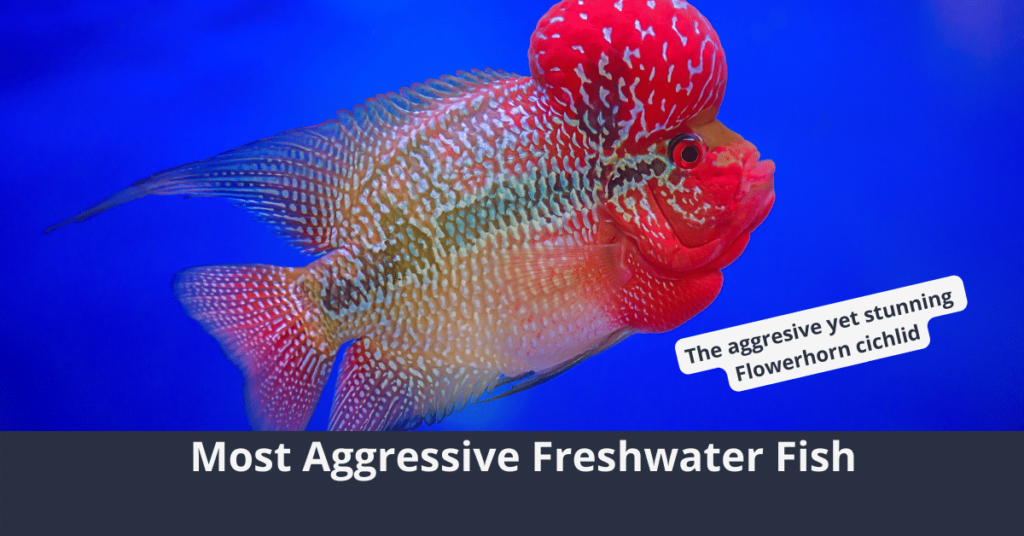A display of aggression is a survival tactic common in many animals, and freshwater fish are no exception to this phenomenon. There are numerous freshwater fish that are often predatory, and we’ve highlighted the ten most aggressive species below – with a few honorable mentions to keep in mind.
Everything you will learn here
Top 10 Most Aggressive Freshwater Fish
Whether you are interested in including aggressive fish in an aquarium or you simply have a hobbyist’s interest in the topic, this list is for you. Let’s take a closer look at ten of the most aggressive freshwater fish in existence.
1. Convict Cichlid
As you will see, our list reflects the fact that the Cichlidae family of fish is one of the most aggressive. Among the many species in this family, one of the most popular is the convict cichlid.
While the name convict cichlid fits for an aggressive fish, hostility is not the inspiration for the name. Instead, it comes from the black and white striped pattern that is the main feature of this fish’s appearance.
You can expect convict cichlids and other cichlids to go to extreme lengths to defend their territory. This can include chasing and attacking any unwelcome fish that happens to arrive at the convict cichlid’s home.
Convict cichlids often employ their aggressive behavior to protect their numerous offspring. This aggressive activity has ensured the survival of many generations of convict cichlids.
2. Mini Dovii
The mini dovii is another variety from the aggressive Cichlidae family that also goes by the name sieve cichlid. This species hails from fresh bodies of water in Mexico and is less popular than many other cichlids.
This fish is most aggressive during breeding times. Because of this, a mini dovii is more likely to exhibit violent behavior when living in a tank with another fish of the same species. The opportunity for mating will bring out the mini dovii’s hostile activity.
As with other fish, the aggressiveness of the min dovii often relates to the protection of its spawn. Despite this priority, male mini dovii fish can become so belligerent that they harm or kill their female companions.
If you own multiple mini dovii fish, you will need to monitor their behavior so that they don’t kill one another or the other fish in the tank. Fortunately, beyond that, caring for a mini dovii proves to be a simple task.
3. Flowerhorn Cichlid
Flowerhorn cichlid is an aggressive freshwater wish with a highly attractive appearance. This fish has brightly colored scales that vary from light yellow to magenta. They also have a prominent bulge above their eyes, which is the inspiration for the flowerhorn name.
You may be surprised to find that the intriguing appearance of the flowerhorn cichlid is not a natural occurrence. Instead, this species arose through hybridization. With its origins in southeast Asia, this hybrid fish has now spread to fish tanks worldwide.
In many regions, flowerhorn cichlid holds an invasive status. The aggressive nature of flowerhorn cichlid allows it to both out-compete and kill native fish species.
Flowerhorn cichlid has some interesting breeding characteristics as well. This species can breed very quickly, which contributes to their invasive tendencies. However, it takes many years for males to reach sexual maturity. This can be frustrating for fish owners hoping to breed their flowerhorn cichlids.
4. Black Wolf Fish
Black wolf fish is a relatively large fish that is native to the Amazon. This fish is willing to attack nearly any other fish in its tank that shares a similar size or is smaller.
This species can reach nearly two feet in length. Accompanying that length is a thick body that features a dark brown coloration. The sides of black wolf fish show a nearly black stripe that follows the length of the body.
Black wolf fish is happy to feed on other smaller fish. As an alternative, you can train your black wolf fish to live off of frozen fish food. However, it can take some time for a black wolf fish to adapt to this new diet.
You can find multiple sizes for black wolf fish. If you don’t have the space to support certain larger varieties, you can opt for a smaller one. Either way, remember that black wolf fish need warm water that mimics its Amazonian home.
(You might be interested in knowing about other Largest Freswater Fish)
5. Tiger Barb
Tiger barb will be an intriguing addition to any fish tank. These fish are small but exceptionally fast swimmers. They often live and swim in groups of around five fish.
These fish only grow to about three inches at most, but that small stature does not prevent them from attacking other fish. Most often, tiger barbs will target fish that have a milder temperament.
The tiger barb attack is not necessarily predatory. It is more of a harassment in which the tiger barb will bite the fins of other species.
Tiger barbs are great fish to own because they are easy to care for. They also have an attractive appearance that includes orange with black stripes, much like a Bengal tiger.
6. Bucktooth Tetra
Bucktooth tetra is aggressive enough to eat other fish species’ flesh but is not technically predatory fish. Instead, it is more appropriate to label them as parasitic.
The reason for this distinction is that bucktooth tetra does now make a specific effort to kill prey. Rather, they nibble on the flesh of living fish to gain their sustenance.
This carnivorous fish is on the smaller side, making it a suitable option for many fish tanks. A 55-gallon fish tank is usually an adequate minimum size.
When owning a bucktooth tetra, you’ll find that they are very fast swimmers with a lovely appearance. You can recognize them easily by their silver bodies and black splotches.
7. Red Tail Shark
The red tail shark comes with an impressive two-toned look. Nearly the entirety of this fish’s body is black, except for the tail fins, which are purely bright red.
For a generally aggressive fish, red tail sharks are surprisingly docile in youth. However, that behavior changes dramatically as the fish matures.
At maturity, the red tail shark is highly territorial. It will bite and continue to chase any fish that enters its area.
Interestingly, the name red tail shark is a complete misnomer. Rather than being a true shark variety, this southeast Asia native is a variety of carp.
8. Oscar Cichlid
There are numerous reasons to own an oscar cichlid. To begin with, they are colorful and intelligent. But above all, oscar cichlid is highly aggressive.
Oscar cichlid is indiscriminate in its feeding habits. As an omnivore, it is happy to eat plants and any small fish that happen to swim nearby.
The aggression of the oscar cichlid reaches its peak during mating periods. However, feeding times are also an opportunity for oscar cichlid to express its inborn hostility.
Oscar cichlid comes from the Amazon River and has a relatively long lifespan. They live for about 20 years, during which time, you can enjoy their compelling behavior and colorful scales.
9. Afer Knife
The afer knife is a somewhat rare species of predatory fish. It comes from the rivers of Africa, where it enjoys spending time under the cover of dense vegetation.
This species typically relies on smaller fish as its primary food source. Try to mimic the afer knife’s habitat with places for it to hide and stalk prey.
If you enjoy watching predatory fish in action, afer knife is the species for you. You’ll get to watch this fish hide until the proper moment when it strikes its prey.
Because of its aggressiveness, it is hard to find companion fish for afer knife. If this is your goal, your best bet is to find companions that are too large for the afer knife to attack.
10. Gourami
Gouramis are an aggressive group of fish that come in several varieties, which include a plethora of intriguing scale colors and patterns.
The commonality among gouramis is their aggressive behavior. This is especially true of males who will attack other fish and each other.
Gouramis are omnivorous, meaning that you have plenty of options for feeding them. When it comes to meat, you can feed them live prey or frozen foods.
Another interesting aspect of gouramis is the way they breathe. These fish have a lung-like organ that lets them breathe air at the surface of the water. This attribute allows them to live in incredibly shallow waters.
(You might be interested in reading about the Most Dangerous Freshwater Fish)
A Few Other Aggressive Freshwater Fish Worthy of Mention
Even though those were the most aggressive species, there are several more that deserve a shout-out as well. Here are some of the honorable mentions that did not quite make it into our top ten list:
- Umbee cichlid
- Poor man’s tropheus
- Dwarf pea puffer
- Jaguar cichlid
Final Thoughts
Whether you’re looking to include an aggressive freshwater fish in your aquarium or avoid overly hostile fish, keep this list handy.
Some of the species listed above are territorial while others are predatory, so keep their hostile behavior in mind if you are considering adding one of these feisty fish to your tank.






